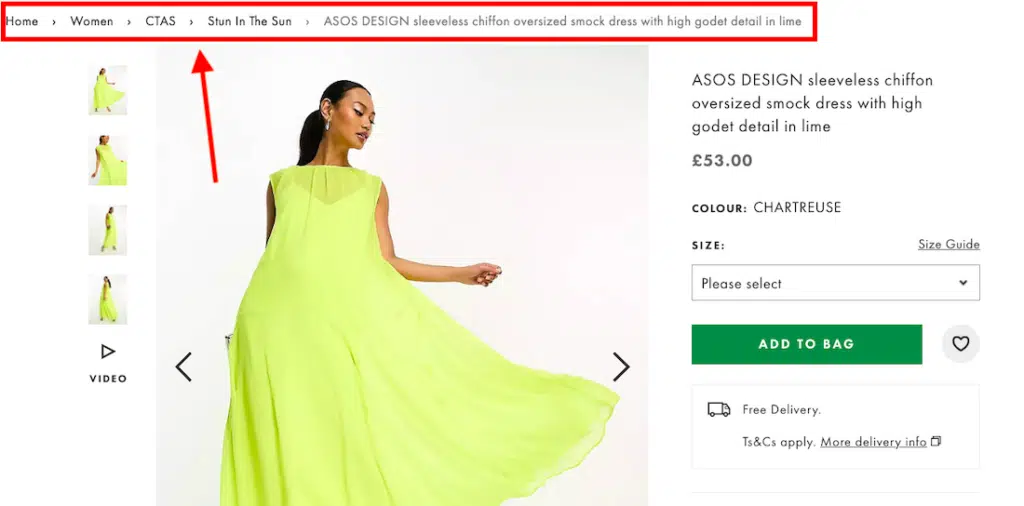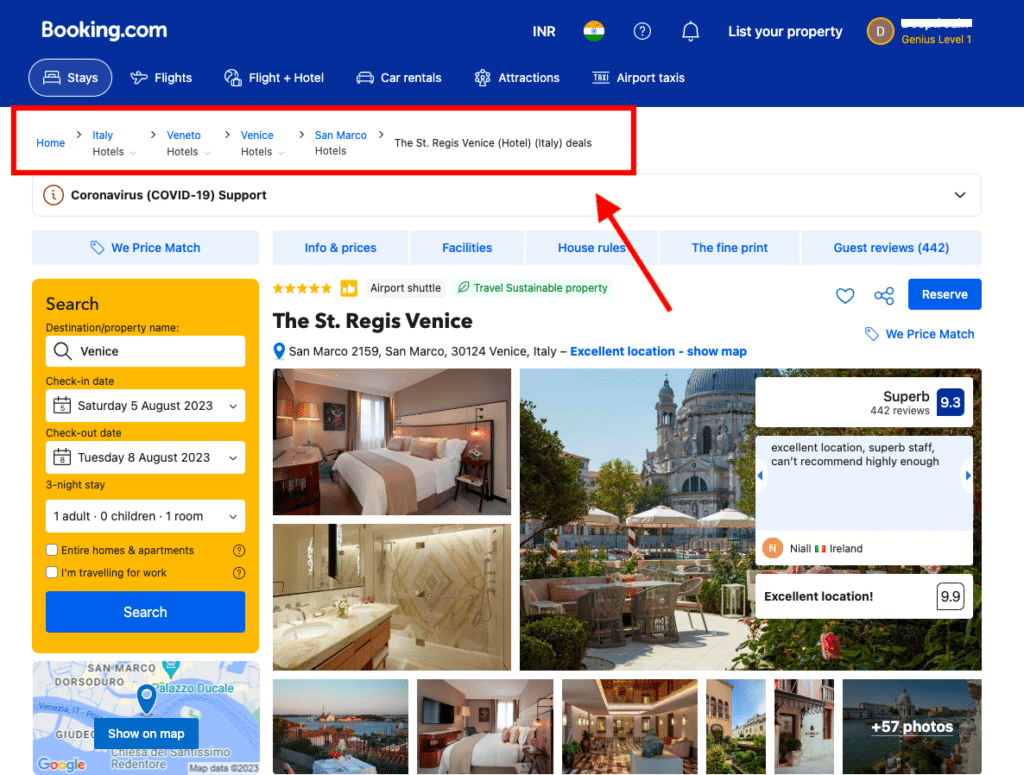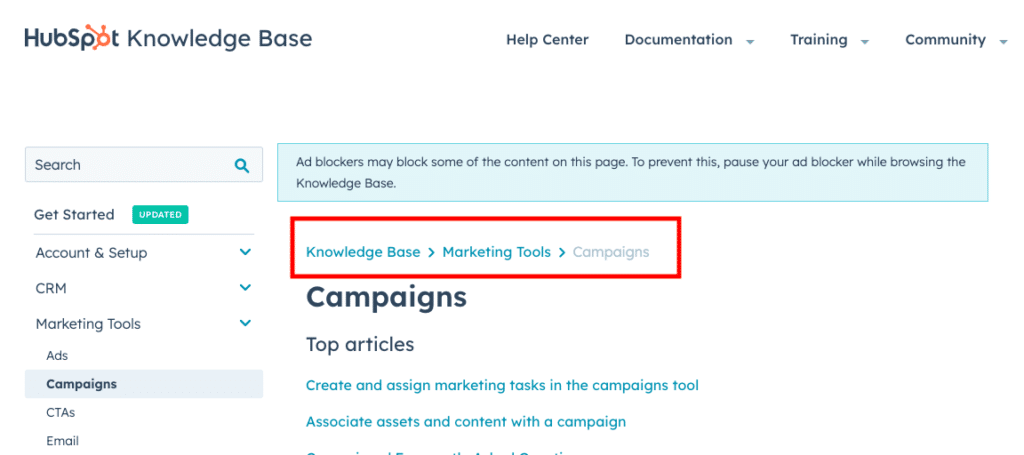Have you ever been lost when browsing the web? A lot of times, it’s not due to a poorly designed site.
It’s because there was no breadcrumb navigation to guide users on where they were and where they could go next.
With better breadcrumbs, your site will be much easier to navigate.
In this article, we’ll look at different types of breadcrumbs and consider how they may benefit or hinder an experience. I’ll also introduce some of my favorites and give examples of how they might look realistically.
Understanding Breadcrumb Navigation
Breadcrumb navigation is a popular design pattern for websites. The idea is to provide users with a trail of links – from the current page back to the homepage – so they can easily navigate your website.
Breadcrumb navigation is often used as a secondary navigation scheme on larger sites, where visitors may want to go deeper into the site hierarchy. It can also be used as an alternative navigation scheme when too many items are in the main menu.
Take breadcrumbs on EdX’s web pages, for instance.
(Source)
The online learning platform offers thousands of courses from various institutions and subjects. Their breadcrumb navigation helps users navigate between different levels of courses, including programs, micro-credentials, professional certificates, etc.
The purpose of breadcrumb navigation is to improve the user experience by making the website easier to navigate and showing the user’s current location. Breadcrumbs can also help with SEO rankings by providing more internal links and making the site more user-friendly.
Types of Breadcrumb Navigation
1. Location-based breadcrumb
Location-based breadcrumbs display a site’s hierarchical structure or path, showing users where they are within your website structure. This makes them ideal for sites with many subdomains or pages that aren’t linked.
For example, if you were building a site for an ecommerce store, then this would be an appropriate breadcrumb to use because it would enable visitors to see where they were within your store structure at all times, even if they weren’t currently viewing a product page or category page, etc.
The location-based breadcrumb could be displayed as “Home > Electronics > Computers > Laptops > Product Name.”
Users can easily navigate back to a higher-level page within the hierarchy by clicking on any of these links.
2. Attribute-based breadcrumb
Attribute-based breadcrumbs include attributes from every level in your website’s hierarchy and give users a complete picture of where they are within your website’s structure.
Let’s say you are browsing a clothing retailer’s website. If you view a category page for women’s dresses, the attribute-based breadcrumbs may appear as “Home > Women > Dresses.”
ASOS’ attribute-based breadcrumbs are a perfect example:
ASOS’s attribute-based breadcrumbs allow you to quickly narrow your search and access specific types of products within the chosen category, providing a more tailored and efficient shopping experience.
3. Path-based breadcrumb
Path-based (or history-based breadcrumbs) are similar to attribute-based breadcrumbs but use actual paths instead of attributes.
Path-based breadcrumbs show only the path from the current page to its parent (for example, “Home > Pets > Dogs > Labradors”).
In this case, “Pets” would be shown as a level within the website hierarchy even though it’s not an actual subcategory of dogs. Instead, it is an intermediate step between “Home” and “Dogs.”
Benefits of Implementing Breadcrumbs on Your Website
Here are some benefits of implementing Breadcrumbs:
1. Enhanced website navigation
Breadcrumbs enhance the navigation of your website by providing a visual map of where you are on your site.
They can help visitors find their way around and inform search engines about the structure of your website.
For instance, Booking.com uses location-based breadcrumbs, which show the user where they are in the site’s structure.
2. Facilitates backtracking and exploration
The breadcrumb trail helps provide users with an overview of their path through a website. If they get lost or need to return to a place they’ve been before, they can easily find their way back by following the breadcrumbs.
An essential part of breadcrumbs is that they indicate the current position in relation to the rest of the site’s content – which means you can use them for both backtracking and exploration purposes.
3. Improved user orientation
The primary purpose of breadcrumbs is to provide users with an overview of where they are on a website. This can be particularly important for large sites with multiple levels of navigation or content pages in different categories or sections.
In this scenario, breadcrumbs can help users quickly find their way back to the homepage or another page they know exists somewhere on your site. This reduces the cognitive load and the frustration of users who might feel lost or confused.
Take Amazon’s breadcrumbs, for example.
The e-commerce giant has a vast catalog of products grouped into categories and sub-categories, such as Books, Electronics, Fashion, etc.
This breadcrumb navigation helps users navigate between different levels of product categories and sub-categories.
For example, if the user is browsing for PlayStation systems, they can see the following breadcrumb navigation:
4. Provides context and hierarchy
Breadcrumb gives your site a hierarchical context (like siblings or parent/child relationships). It allows you to display the hierarchy of the current page in the URL instead of just showing the page name.
This helps users understand how they fit into the site at large, and it helps them navigate back up through that hierarchy if needed.
5. Breadcrumbs come with SEO benefits as well
Breadcrumbs help Google and other search engines understand your content structure better.
This can help with Search Engine Optimization efforts because it helps them determine which pages to show in search results. It also helps them show links to those pages on their SERP for specific queries.
Best Practices for Implementing Breadcrumb Navigation
Breadcrumb navigation is a great way to help users find their way around your website. But breadcrumbs can be tricky to implement well.
Here are some best practices for implementing breadcrumb navigation:
1. Clear and concise labels
The purpose of breadcrumb navigation is to help users understand their location in the site structure.
To do this, you need clear, concise labels for each level in the hierarchy – not just for the top-level pages but also for any other levels that may be nested within those top levels (such as subcategories).
So, resist the urge to include excessive levels of information in your breadcrumbs.
For example, if a page is only one step above another in the hierarchy, don’t include both pages in your breadcrumb – just include the higher level page (in this case, “Home”).
2. Make sure it’s always obvious where you are in the hierarchy.
Breadcrumbs are helpful only if people can understand them at a glance. Color coding is one way to accomplish this goal.
For example, let’s say your site has multiple levels of navigation — such as “Home,” “Home > Products,” and “Products > Clothing.”
In that case, color code each level so that users can tell which level they’re on by looking at the breadcrumb trail on their browser window’s left or right side.
Use clear language for each level so that users know exactly what each step is about when they see it on their screen (for example, instead of saying “Clothing,” say “Men’s Clothing”).
3. Consistent placement and styling
Place your breadcrumb at the top of the page in a consistent place that doesn’t distract from other content. It could be either above or below the logo or branding area but not directly to the left or right.
This way, you ensure it’s visible without distracting from other content on your page.
At the same time, the styling of your breadcrumbs should be consistent across all pages on your site. It’s best if they match the style of other elements on your site (like buttons) so they look like they belong together as part of an overall design system rather than being thrown in there randomly by different designers over time.
For instance, HubSpot’s Knowledge Base always has breadcrumbs near the top of the page, under the search bar.
They also have a consistent style with the color and font style that aligns with the rest of their branding elements.
4. Responsive design considerations
Consider a scenario where a user is browsing the website on a desktop computer and reaches a product page for “Home > Electronics > TVs > Brand X.”
You can see that the breadcrumb navigation is displayed horizontally, allowing the user to follow the navigation trail easily.
However, if you access the same website on a smaller device (like a mobile phone), the horizontal breadcrumb navigation may not fit well within the limited screen space. This is where responsive design comes into play.
Here are some tips for implementing effectively:
Collapse your breadcrumb navigation into a dropdown menu to align with smaller screens. Users can tap on it to expand and view the breadcrumb links when needed.
Here’s an example. This option combines breadcrumbs with dropdown menus for each link, allowing users to access subcategories or related pages without leaving the current page.
(Source)
You can also consider vertical alignment when the space is limited horizontally, like in the example below.
(Source)
This option arranges the breadcrumb links vertically instead of horizontally, saving horizontal space and fitting better on narrow screens.
If the breadcrumb trail becomes lengthy or complex, you could hide or truncate certain links to keep the display clean and concise.
5. Proper integration with other navigation elements
When it comes to breadcrumbs, there’s a lot of confusion. Is it supposed to be “Home > Products” or “Products > Home”? Should it be “Home > Products > Special Offers” or “Special Offers > Products”?
Well, that all depends on the context.
Breadcrumbs are not meant to be stand-alone items or your primary navigation menu. It’s better to use them as an additional way to navigate, not as the primary one by navigating breadcrumbs with your other navigation elements.
But how do you go about it?
For starters, integrate the breadcrumb navigation with the website’s search functionality. When users perform a search and land on a specific page, the breadcrumb navigation should accurately reflect the search context.
For example, if a user searches for “latest tech news” and clicks on a search result that leads to an article titled “Top Tech Trends of 2023,” the breadcrumb navigation could display “Home > Technology > News > Top Tech Trends of 2023.”
This integration will help your audience understand their search context and navigate within the broader website structure.
Potential Challenges and Considerations While Implementing Breadcrumbs
Breadcrumbs are a great way to help users get around your site, but they can be tricky to implement if there’s not enough information available or the information isn’t organized correctly.
Here are some challenges you might face and the things to consider:
Complex website structures
If your website has a complex structure with multiple levels of hierarchy (such as a departmental structure), it will be difficult for the user to understand where they are.
If this is the case, you may need to implement a more complex version of breadcrumbs that allows users to drill down into sub-sections of your site.
For example, if you have multiple levels of pages and want to show the full path in the breadcrumbs, you might end up with something like this: Home > Blog > Article 1 > Article 2 > Article 3 > Article 4.
You may also face issues with:
- Duplicate content: If you have duplicate content on your site (e.g., different URLs for the same page), this can cause issues with breadcrumbs because they will only show one URL for each page. For example, if two pages have an article title of “Article 1”, then it’s challenging to determine which page contains what content and information if both pages display the same title in their breadcrumbs.
- Duplicate titles: Similar to duplicate content, duplicate titles can also cause issues with breadcrumbs by displaying multiple titles in each step of the navigation trail (e.g., “Article 1” and “Article 1”).
Multilingual Websites
If you have many languages on your site, you may need to create unique breadcrumbs for each language.
Otherwise, users might not understand the breadcrumb trails easily because they don’t know the language being used in the breadcrumb trail.
It can become complicated if one of these languages is chosen as the default language for your website. This would also mean that users who aren’t logged into their accounts wouldn’t see any breadcrumb trails.
Mobile and touch-based interfaces
Touch-based interfaces and mobile devices have limitations that don’t affect desktop computers.
If you’re using breadcrumbs on your website, you’re probably doing it because you want to give users an easy way to get back to the main page without having to remember what page they were on. Breadcrumbs are also useful for SEO purposes.
However, implementing breadcrumbs can be tricky if you use them on mobile devices or touch-based interfaces.
A great turnaround to this is using vertical or drop-down breadcrumbs (as we talked about above).
The Breadcrumb Bonanza: Navigating Towards User Delight!
Breadcrumb navigation offers a range of benefits that significantly enhance the user experience and streamline website navigation. By providing improved user orientation, users can effortlessly understand their location within the website’s structure, making it easier to explore related content and backtrack when needed.
Breadcrumb navigation also promotes efficient navigation by offering clear pathways and allowing users to switch between different website sections easily.
With proper integration with other navigation channels and responsive design considerations, breadcrumb navigation becomes indispensable for ensuring a seamless and cohesive user experience across various devices.
So, whether for running e-commerce websites, news platforms, or any other content-rich site, website breadcrumbs navigation is a wise choice to enhance user satisfaction and engagement.












